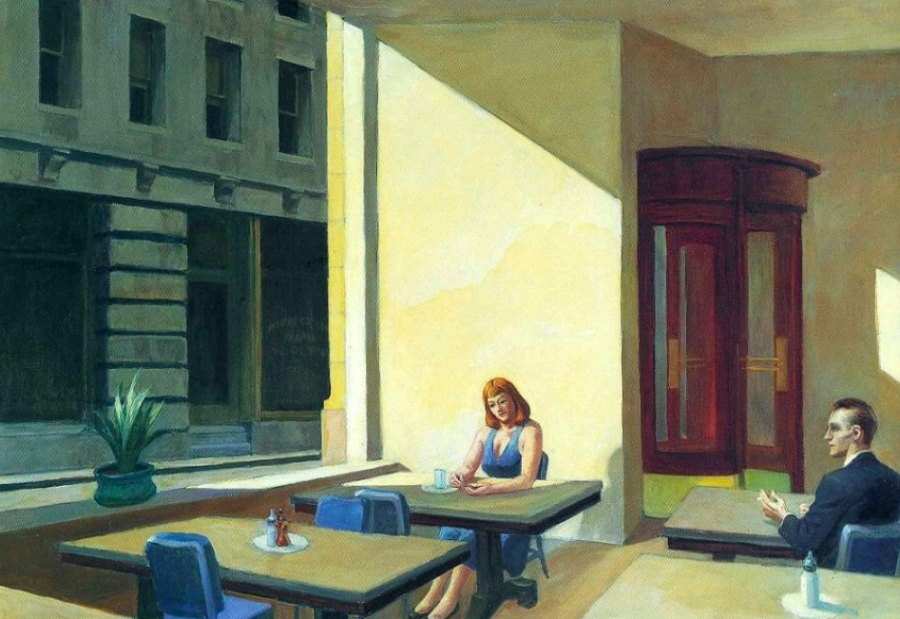Appreciating ‘Sunlight in a Cafeteria’
December 3, 2020
My dad and I never talked a lot because he always had business until 3 o’clock in the morning, and the very few times when we did talk, he was trying to lecture me about his philosophy on life. I‘m in an age of independent thinking, so I sometimes unconsciously became a little sarcastic in our conversations. As a result, he thought I was too cynical and sensitive, while I believed he was arrogant.
Things changed this September. He came home one night when I had just finished school.
Mom was snoring. The whole city was sleeping. He knocked on my door and came in. There was only one desk lamp on. A dim light blurred half of his face, so I could only see the tiredness and cautiousness in the wrinkles near his eyes.
“Hey.. Eh..what are you doing?” His voice was a little unnatural, probably because he was wondering whether we would have an intense conversation again.
“Looking at a painting.”
“Oh, paintings. Why don’t you watch some games?“
I frowned. He mumbled a few words and came in. He stood there, strong, a barrel-like belly, typical acute eyes of a businessman, seeming like an insensitive person.
”Okay. Let’s see.” He leaned down to my computer. “What painting is that?“
“Sunlight in a Cafeteria.”
“Sorry, What?”
But he sat down on the bed reluctantly.
And so I told my father about Sunlight in a Cafeteria. It was painted by Edward Hopper in 1958, and now it is in the Yale University Art Museum permanent collection. Hopper’s works often depicted loneliness in modern life. He focused on portraying the American city and the countryside, but strangely, the buildings, the people and the scenery under his brushes are all silent and still, giving people a sense of hollowness. Hopper was good at adding ingenious metaphorical elements into his artwork, and Sunlight in a Cafeteria showcased his ability to capture subtle and ordinary beauty in real life.
In this painting, the faintly visible but tense relationship between strangers emerges on the canvas. It is afternoon. The city is lonely. The streets and the buildings are outside. No one is walking. A man and a woman sit at different tables in the sunny restaurant, and they seem like the only two customers there.
The woman puts her empty glass aside and plays with her fingers. Her head is down to one side and shyness rises in her rosy cheeks, an indication that she is not busy and is Indirectly inviting the man to talk . On the other side, the man gazes at the windows. He has a cigarette in his hands, and awkwardly leans to the left; it seems like he is going to buy the woman another drink. Perhaps he is going to ask the woman out.
At the same time, the lights also indicate their connection and alienation; although the woman is under the sun while the man is in the shadow, they can be familiar with each other by simply being near one another.
Hopper didn’t like to explain too much about the concepts of his painting; he would only say that ”all the answers are on the canvas.” This vagueness allows audiences to fill in the blanks with their imagination.
The two people in the painting are strangers, and the emptiness and quiet of the scene reinforces a sense of loneliness, but Hopper ironically used this universal loneliness to attach people and establish connection as he did in Sunlight in a Cafeteria.
With all the careful details and the sunlight pouring into the restaurant, audiences can freely imagine that time and space in this cafeteria will be frozen in that moment, but in the next second, anything could happen. Romance is the second before a conversation starts.
I finished telling my dad about the painting, and found that he was looking at me. He frowned but tears glittered like lights in his eyes. Maybe this was the first time he realized I was no longer eight years old.
“Good..I mean..” He carefully chose the words, and I saw a quick fragile flash across his face. “I don’t know. I sometimes feel I miss a lot of things…you told everything to your mom. The last time I bought pears back ‘cause I remember you liked them.” His voice was low in the night. “…and your mom said you don’t like them anymore.”
I felt I needed to say something, but it’s hard. My family is not good at saying how we feel to our loved ones, so I looked outside the window. The night felt like a dark, rippling ocean with faraway lights, like little fish, glistening in the water. The whole world seemed to only have me and my dad now.
“You are amazing.” I heard my dad say.
“Thank you.” I whispered.
“Art is cool.” He quickly realized he was a little emotional. So he coughed, and softly said, ”Good night.”
“Good night.”
Gentleness is the second after a conversation ends.



Steve Hall • Mar 4, 2021 at 8:36 am
Really nice article! Your writing is fluid and captivating. Thank you